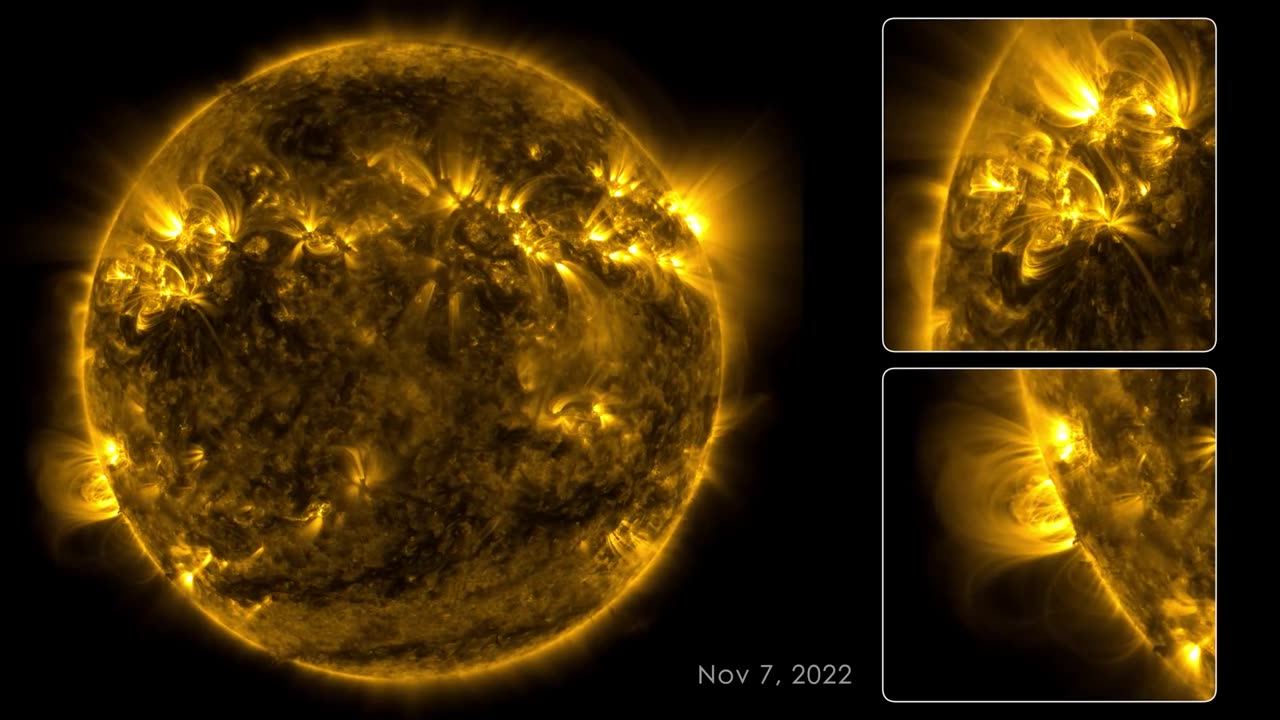Premium Only Content

133 Days on the Sun
Solar activity spanning from August 12 to December 22, 2022, as observed by NASA's Solar Dynamics Observatory (SDO). Orbiting Earth, the SDO has consistently captured high-resolution (4K x 4K) images of the Sun for nearly 13 years. This data has led to numerous insights into the Sun's behavior and its impact on the solar system. Equipped with a trio of instruments, the SDO captures a Sun image every 0.75 seconds. Among these instruments, the Atmospheric Imaging Assembly (AIA) captures images at 10 different wavelengths of light every 12 seconds. The following 133-day sequence spotlights images taken at 17.1 nanometers, an extreme-ultraviolet wavelength exposing the Sun's outermost atmospheric layer known as the corona.
This 133-day interval, condensed into a 59-minute movie, is created by assembling images taken 108 seconds apart. It showcases the passage of bright active regions across the Sun's surface as it rotates. The Sun completes a rotation roughly every 27 days. Extending above these radiant areas are magnetic field-induced loops containing superheated plasma. These bright regions are also the origin of solar flares, manifesting as intense flashes during magnetic field realignments, a process termed magnetic reconnection.
While the SDO has vigilantly focused on the Sun, there have been instances of missed observation. Certain dark frames in the video result from Earth or the Moon blocking the SDO's view, passing between the spacecraft and the Sun. Additional disruptions arise from instrument downtime or data inaccuracies. Transmitting 1.4 terabytes of data daily, the SDO's images sometimes display an off-center Sun, a result of instrument calibration.
The SDO, alongside other NASA missions, will persist in monitoring the Sun, unveiling further insights about our cosmic context and ensuring astronaut and asset safety. The accompanying music is a continuous blend sourced from Lars Leonhard's "Geometric Shapes" album, used with the artist's permission. The video is freely shareable and downloadable at the provided NASA link. While the video content can be shared without explicit permission, certain components such as the music and select imagery may be subject to permissions and usage limitations. For more information on NASA's media guidelines, visit their official website. The visual description of the video includes the Sun on the left side, depicted in golden yellow hues with intermittent wisps and brightness variations. The Sun rotates steadily, requiring 12 minutes per full rotation in the time-lapse. Bright regions shift and flicker akin to small fires, accompanied by dynamic loops extending above. The right side of the frame features two outlined squares with magnified views of intriguing Sun regions.
-
 LIVE
LIVE
Lofi Girl
2 years agoSynthwave Radio 🌌 - beats to chill/game to
523 watching -
 5:52:00
5:52:00
Akademiks
10 hours agoWAR IN ATLANTA Episode 5. YOUNG THUG FIRST INTERVIEW about SNITCHING, GUNNA... BREAKS DOWN CRYING!
147K7 -
 7:30:25
7:30:25
SpartakusLIVE
13 hours agoVerdansk Duos w/ Nicky || Saturday Spartoons - Variety Later?!
51.7K1 -
 1:38:47
1:38:47
Badlands Media
1 day agoDevolution Power Hour Ep. 387: Trump, Epstein, Durham Mysteries, and North Korea Ops
84.3K25 -
 1:05:23
1:05:23
Man in America
17 hours agoSoaring Gold Exposes the Imminent Crash of the Old System w/ John Perez
43.3K9 -
 2:42:40
2:42:40
TruthStream with Joe and Scott
17 hours agoTHOMAS AND GROK: AI, Bible decodes, The JESUS Cube live 9/6 #487
29.9K10 -
 2:34:46
2:34:46
BlackDiamondGunsandGear
12 hours agoGet Prepped / After Hours Armory / LIVE SHOW /
20.2K1 -
 2:01:39
2:01:39
Tundra Tactical
10 hours ago $8.30 earned🛑LIVE NOW!! This spits in the face of the Second Amendment.🛑
31.2K8 -
 2:34:46
2:34:46
DLDAfterDark
9 hours ago $2.51 earnedIt's SHTF! Do You Have What You Need?? Let's Review Items & Priorities
22.1K6 -
 28:58
28:58
Stephen Gardner
10 hours ago🚨Explosive allegations: Rosie O’Donnell connects Trump to Epstein scandal!?
38.8K84